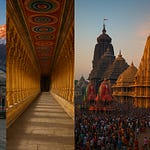A Singular Blend of Tradition and Technology
In the bustling city of Indore, the annual Ganesh Chaturthi festival is celebrated with fervent devotion and spirited joy. However, one temple in particular - the Chintaman Ganesh Temple - has gained special acclaim for merging centuries-old devotion with modern communication methods. Here, devotees connect with Lord Ganesha not just through rituals, but via phone calls and letters, a practice that has resonated deeply across India and beyond.
In the vibrant city of Indore, Madhya Pradesh, stands a shrine that blends over a millennium of history with the rhythms of modern devotion. The Chintaman Ganesh Temple, also known as Juna Chintaman Mandir, is among the oldest temples dedicated to Lord Ganesha in central India. Here, worship is not limited to traditional rituals -devotees also reach out through letters and phone calls, making the temple famous as both the “Letter Ganesh Temple” and the “Mobile Ganesh Temple.”
Historical Background
The temple’s origins trace back nearly 1,200 years to the Paramara dynasty. Built in the medieval era, it reflects the dynasty’s patronage of religion and art. Its name Chintaman is derived from the Sanskrit word chinta (worry) and mani (gem), symbolizing Lord Ganesha as the remover of worries and obstacles.
Over the centuries, the temple became a spiritual refuge for traders, rulers, and common folk alike. Families across Malwa and beyond consider it auspicious to visit Chintaman Ganesh before embarking on new ventures, marriages, or important milestones.
Architecture
Though simple at first glance, the temple holds within it a wealth of artistic and spiritual significance:
Sanctum (Garbha Griha): The sanctum houses a swayambhu (self-manifested) idol of Lord Ganesha, carved from a single stone. The idol exudes serenity and is adorned with ornaments during major festivals.
Mandapa (Hall): A large pillared hall welcomes devotees, its stone columns bearing intricate carvings of floral and mythological motifs, typical of Paramara craftsmanship.
Murals and Reliefs: Faded murals on the walls depict stories from Hindu epics, while sculpted motifs preserve fragments of medieval artistry.
Courtyard and Entrance: The spacious courtyard accommodates large gatherings, especially during Ganesh Chaturthi, when the temple comes alive with music, rituals, and cultural programs.
Even after centuries of renovations, the temple retains the aura of antiquity, making it both a historical monument and a vibrant spiritual hub.
Rituals and Worship
Daily Worship
Aartis are performed multiple times a day with devotional chants, bells, and drums.
Devotees offer modaks, coconuts, sweets, flowers, and garlands.
Unique Practices
Letters of Faith: For the past three decades, devotees have been sending letters with prayers and requests. Priests read these before the deity.
Phone Calls: Since 2005, the temple accepts prayers via phone. Priests place the phone close to the idol, allowing devotees - even abroad - to offer supplications.
Festivals: Ganesh Chaturthi sees the temple adorned with elaborate decorations. Thousands of devotees gather, and hundreds of calls and letters arrive daily.
Special Pujas and Dosha Remedies
The temple is not only a place of worship but also a center for astrological and spiritual remedies. Devotees often visit to perform pujas to alleviate graha doshas (planetary afflictions) and karmic obstacles.
Some of the most common rituals include:
Mangal Dosh Nivaran Puja: Performed for individuals afflicted by Mangal Dosha (Mars affliction), often linked to delays or obstacles in marriage.
Kaal Sarp Dosh Puja: Conducted to pacify the negative effects of Rahu and Ketu alignment, believed to cause hurdles in career, health, and relationships.
Santaan Prapti Puja: For couples seeking blessings for children.
Vighna Nivaran Puja: A special ritual dedicated to Lord Ganesha to remove obstacles in new ventures, business growth, and personal life.
Nakshatra and Graha Shanti Puja: To pacify malefic planetary positions and ensure peace and harmony in life.
Sankashti Chaturthi Vrat & Puja: Observed monthly on the fourth day after the full moon, with devotees fasting and offering prayers for relief from difficulties.
Ganesh Atharvashirsha Path: Recitation of the sacred text for prosperity, wisdom, and removal of obstacles.
These rituals are often personalized based on an astrologer’s guidance, and priests at the temple perform them with traditional Vedic mantras and offerings.
Legends and Beliefs
The Worry Remover: Devotees believe that Lord Ganesha at Chintaman Temple has special powers to remove mental stress, fears, and worldly obstacles.
Global Reach: From letters to mobile calls, devotees worldwide share testimonies of fulfilled wishes.
Generational Faith: Many Indore families maintain the tradition of visiting Chintaman Ganesh before every new venture, treating the temple as their guardian of fortune.
Indore’s Ganesh Chaturthi Celebrations
While the city of Indore celebrates Ganesh Chaturthi with grand pandals and towering idols, Chintaman Ganesh Temple holds its own charm. Unlike the temporary installations, the temple embodies the living, ancient presence of Ganesha, drawing thousands during the ten-day festival.
The temple’s uniqueness - accepting prayers across continents - sets it apart from all other shrines. Even devotees unable to attend in person feel spiritually present.
Visiting the Temple
Location: Juni Indore (Old Indore), easily accessible by road.
Timings: Open from dawn until late evening; aartis are the most auspicious times.
Best Time: Ganesh Chaturthi, Sankashti Chaturthi, or Tuesdays (considered auspicious for Ganesha worship).
The Chintaman Ganesh Temple in Indore is more than just an ancient shrine - it is a spiritual bridge across time and distance. Its medieval roots remind us of India’s sacred architectural heritage, while its modern practices of phone and letter prayers reflect adaptability in faith.
With its daily worship, vibrant festivals, and powerful dosha-nivaran pujas, the temple remains a sanctuary for those seeking peace, prosperity, and divine intervention.
Here, under the gaze of the stone-carved Lord Ganesha, devotees find comfort in the belief that no prayer goes unheard - whether spoken softly in the sanctum, penned in a heartfelt letter, or carried across the world through a simple phone call.











